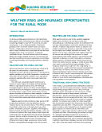Resilience: A primer
Hoddinott, John
মে ২০১৪ · 2020 Conference Brief বই 8 · Intl Food Policy Res Inst
৫.০star
১টি রিভিউreport
ই-বুক
4
পৃষ্ঠা
family_home
উপযুক্ত
info
reportরেটিং ও রিভিউ যাচাই করা হয়নি আরও জানুন
এই ই-বুকের বিষয়ে
Recurrent humanitarian crises have led many development actors to begin thinking differently about development issues. Rather than placing humanitarian assistance, governance, food security and nutrition, economic development, and other topics in separate silos, many are using the concept of resilience to join up their myriad activities. Constas, Frankenberger, and Hoddinott wrote, In a world where conventional approaches to dealing with humanitarian aid and development assistance have been questioned, resilience has captured the attention of many audiences because it provides a new perspective on how to effectively plan for and analyze the effects of shocks and stressors that threaten the well-being of vulnerable populations. Despite the promise and hype of resilience, or perhaps because of it, a backlash has already begun. Does it really add new and useful understanding to development theory and practice, or is it merely more development jargon? This brief addresses this concern through an overview of what resilience means and how it is conceptualized before discussing implications for measurement and for policy.
রেটিং ও পর্যালোচনাগুলি
৫.০
১টি রিভিউ
ই-বুকে রেটিং দিন
আপনার মতামত জানান।
পঠন তথ্য
স্মার্টফোন এবং ট্যাবলেট
Android এবং iPad/iPhone এর জন্য Google Play বই অ্যাপ ইনস্টল করুন। এটি আপনার অ্যাকাউন্টের সাথে অটোমেটিক সিঙ্ক হয় ও আপনি অনলাইন বা অফলাইন যাই থাকুন না কেন আপনাকে পড়তে দেয়।
ল্যাপটপ ও কম্পিউটার
Google Play থেকে কেনা অডিওবুক আপনি কম্পিউটারের ওয়েব ব্রাউজারে শুনতে পারেন।
eReader এবং অন্যান্য ডিভাইস
Kobo eReaders-এর মতো e-ink ডিভাইসে পড়তে, আপনাকে একটি ফাইল ডাউনলোড ও আপনার ডিভাইসে ট্রান্সফার করতে হবে। ব্যবহারকারীর উদ্দেশ্যে তৈরি সহায়তা কেন্দ্রতে দেওয়া নির্দেশাবলী অনুসরণ করে যেসব eReader-এ ফাইল পড়া যাবে সেখানে ট্রান্সফার করুন।










